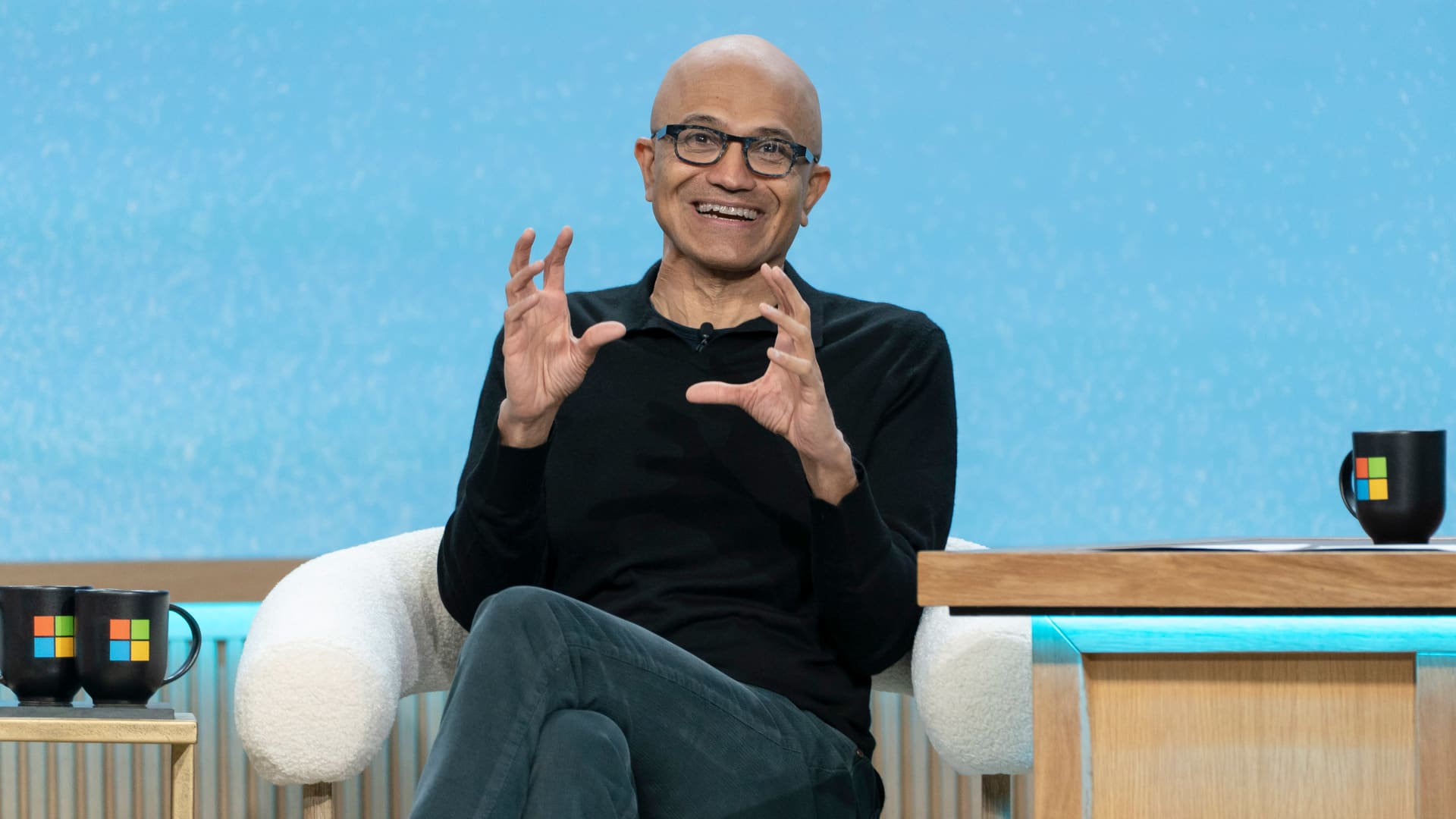Microsoft’s shares rose 9% after reporting strong quarterly results, with earnings per share of $3.46 and revenue of $70.07 billion, surpassing analyst expectations. The company expects future revenue between $73.15 billion and $74.25 billion, driven by a projected 34-35% growth in Azure. CEO Satya Nadella announced plans to invest $80 billion in AI-related data centers, despite potential tariff impacts. Azure’s revenue grew by 33%, aided by AI, and 15 million users now utilize GitHub Copilot. The Productivity segment increased by 10%, while More Personal Computing saw a 6% rise in revenue, as Windows 11 adoption surged among commercial clients.
At an event marking the 50th anniversary of Microsoft, CEO Satya Nadella addresses attendees at the Microsoft headquarters in Redmond, Washington, on April 4, 2025.
David Ryder
Microsoft shares surged nearly 9% in after-hours trading on Wednesday, following the company’s announcement of quarterly results that exceeded expectations, largely due to strong performance in its Azure cloud segment, along with a robust outlook.
Here’s how the results stacked up against LSEG consensus:
- Earnings per share: $3.46 compared to the expected $3.22
- Revenue: $70.07 billion versus the anticipated $68.42 billion
Microsoft projected revenue between $73.15 billion and $74.25 billion, and the midpoint of this range surpassed LSEG’s consensus of $72.26 billion. The company anticipates Azure revenue growth of 34% to 35% at constant currency, exceeding StreetAccount’s 31.5% expectation.
Management noted that while capital expenditures are expected to increase in the new fiscal year, the growth rate will be slower than that of the current 2025 fiscal year. The expected operating margin of 43.35% was just below StreetAccount’s 43.5% estimate.
The company reported a 13% year-over-year revenue increase for the fiscal third quarter ending March 31. Net income rose 18%, amounting to $25.8 billion, up from $21.9 billion, or $2.94 per share, from the previous year.
Despite surpassing earnings and revenue expectations, these figures reflect past performance. Concerns regarding President Donald Trump’s recent tariffs, announced in early April, led to some investor relief following the company’s optimistic outlook for the remainder of the year.
This year, CEO Satya Nadella mentioned that Microsoft plans to allocate $80 billion in fiscal 2025 to construct data centers capable of supporting artificial intelligence workloads. This initiative is reliant on significant imports, which may lead to increased costs depending on the tariffs implemented.
During the quarter, Microsoft maintained its substantial investment in AI infrastructure. Capital expenditures, excluding finance leases, soared to $16.75 billion, nearly a 53% increase. Analysts from Visible Alpha had predicted expenditures of $16.37 billion.
Azure revenue expanded by 33%, with 16 percentage points attributed to AI. In contrast, analysts surveyed by StreetAccount and CNBC forecasted growth of 30.3% and 29.7%, respectively.
Previously, in January, Microsoft identified shortcomings in its non-AI Azure cloud execution among partners. However, CFO Amy Hood noted an improvement during this quarter in a conference call with analysts, stating, “Things were a little better, and we still have some work to do in our scale motions and we’re encouraged by our progress.”
In AI, Microsoft increasingly brought additional capacity online at a faster rate than anticipated, Hood added.
“Demand is growing a bit faster,” she noted. “Thus, we now foresee some AI capacity constraints extending beyond June.”
The Intelligent Cloud division, which includes Azure, generated $26.75 billion in revenue, representing approximately a 21% increase and exceeding StreetAccount’s $26.16 billion forecast.
Microsoft reported that more than 15 million users are currently utilizing its GitHub Copilot assistant, four times the number from the previous year, as stated by Nadella during Wednesday’s call.
Revenue within the Productivity and Business Processes segment, which comprises Office software subscriptions and LinkedIn services, rose 10% to $29.94 billion, surpassing the $29.57 billion consensus from StreetAccount. However, LinkedIn’s Talent Solutions for recruiters “continues to be affected by weaknesses in the hiring market,” Hood explained.
Within the More Personal Computing segment, encompassing Windows, search advertising, devices, and gaming consoles, revenue increased 6% to $13.37 billion, exceeding the $12.66 billion consensus by StreetAccount.
Microsoft reported a 3% rise in sales of devices and Windows operating licenses to manufacturers, despite elevated inventory levels caused by tariff uncertainties. According to Gartner, a technology research firm, PC shipments grew by 4.8% during the quarter.
“We are witnessing enhanced commercial momentum as we near the end of support for Windows 10,” Nadella stated. Support for the operating system released in 2015 is set to conclude in October. Deployments of the new Windows 11 among commercial clients increased by about 75%, he added.
During the quarter ending March 31, Microsoft adjusted its relationship with its AI partner OpenAI, granting it the right of first refusal for new computing capacity, although it won’t always have to provide it. Simultaneously, OpenAI announced the Stargate AI infrastructure project in collaboration with Oracle and SoftBank at the White House.
Microsoft reported $623 million in “other expenses” for the quarter, including losses recognized on equity investments, such as OpenAI. This figure was $2.29 billion in the previous quarter.
As of Wednesday’s market close, Microsoft shares were down 7% year-to-date, while the S&P 500 index declined approximately 6%.
WATCH: Trade Tracker: Karen Firestone buys more Microsoft
